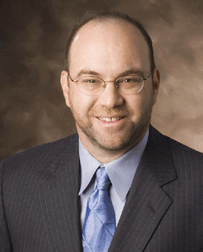Jonathan Borden
| Jonathan Borden | |
|---|---|
 | |
| Born | October 31, 1962 |
| Residence | Cincinnati, Ohio, USA |
| Occupation | Neurosurgeon |
| Website | |
| http://jborden.org/etc/ | |
Jonathan Alan Borden is an American neurosurgeon who developed the Borden Classification of Dural Arteriovenous Fistulas. He has been involved in internet based telemedicine applications and is an editor of the RDDL specification for XML Namespaces.
Education
Jonathan Alan Borden, born October 31, 1962 in Rochester, New York, raised in Hartford, Connecticut. Borden graduated from Amherst College in Amherst, Massachusetts with a Bachelor of Arts in Neuroscience and Yale University School of Medicine. He completed his internship and residency in Neurosurgery at Tufts University in Boston, Massachusetts.
Research
His scientific work has involved the application of computer science to neurobiology. His earliest work used artificial intelligence techniques to model neurochemical networks in the brain. He used computer graphics techniques to analyze the results of traditional molecular biological experiments. Working in the laboratory of Elias Manuelidis and Laura Manuelidis at Yale School of Medicine, he authored papers on the organization of interphase chromosomes in human brain tissue.[1][2][3]
At Tufts-New England Medical Center he developed the Borden Classification of Dural Arteriovenous Fistulas.[4] This classification has come into common usage after its clinical applicability has been verified by the University of Toronto Brain AVM Group[5]
Dr. Borden was an Assistant Professor of Neurosurgery at Tufts University in Boston from 1995 to 2002. He was the director of the Boston Gamma Knife Center. He and Tim Bray are co-editors of the RDDL specification.[6] He authored the XMTP specification,[7] an early method to represent SMTP/RFC 811 email in XML. He is an advisor for the Science Directorate of NASA, has been an invited expert for the World Wide Web Consortium Web Ontology Working Group and has been actively involved in the development and standardization of XML based electronic medical records.[8]
More recently Dr. Borden has been involved in research studies aimed at repairing degenerated intervertebral discs using growth factors,[9] stem cells and minimally invasive surgical techniques.[10]
References
- ↑ Borden J, Manuelidis L (December 1988). "Movement of the X chromosome in epilepsy". Science 242 (4886): 1687–91. doi:10.1126/science.3201257. PMID 3201257.
- ↑ Manuelidis L, Borden J (1988). "Reproducible compartmentalization of individual chromosome domains in human CNS cells revealed by in situ hybridization and three-dimensional reconstruction". Chromosoma 96 (6): 397–410. doi:10.1007/BF00303033. PMID 3219911.
- ↑ Cremer T, Lichter P, Borden J, Ward DC, Manuelidis L (November 1988). "Detection of chromosome aberrations in metaphase and interphase tumor cells by in situ hybridization using chromosome-specific library probes". Human Genetics 80 (3): 235–46. doi:10.1007/BF01790091. PMID 3192213.
- ↑ Borden JA, Wu JK, Shucart WA (February 1995). "A proposed classification for spinal and cranial dural arteriovenous fistulous malformations and implications for treatment". Journal of Neurosurgery 82 (2): 166–79. doi:10.3171/jns.1995.82.2.0166. PMID 7815143.
- ↑ Davies MA, TerBrugge K, Willinsky R, Coyne T, Saleh J, Wallace MC (November 1996). "The validity of classification for the clinical presentation of intracranial dural arteriovenous fistulas". Journal of Neurosurgery 85 (5): 830–7. doi:10.3171/jns.1996.85.5.0830. PMID 8893721.
- ↑ Borden, Jonathan; Bray, Tim (March 5, 2001). "Resource Directory Description Language (RDDL)".
- ↑ Borden, Jonathan (April 24, 2001). "XML MIME Transformation Protocol (XMTP)".
- ↑ "ASTM XML Document Type Definitions (DTDs) for Health Care" (Press release). ASTM. March 14, 2001.
- ↑ "rhGDRF-5".
- ↑ "Percutaneous Dynamic Stabilization (PDS) System Versus Fusion for Treating Degenerative Disc Disease". National Library of Medicine. May 13, 2010.